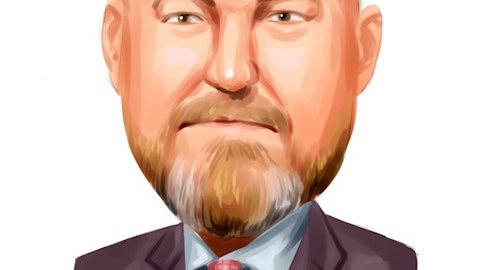Ryan Marshall: Yes, in the fourth quarter, it was $105,000 per unit, so it’s down about $4,000 versus the prior year. And so, I think that speaks to the sales team, and I give them a lot of credit. Where we’ve needed incentive has been less around options and lot premiums and more oriented towards financing. So, we didn’t see a big change there, which I think is a real positive. It also is – interestingly, for that move-up in active adult buying, we’ve highlighted the relative strength from them in this quarter and the relative pricing strength there. So, just like our first time was down about 6%, our move-up pricing was actually flat quarter-over-quarter, and our active adult was actually tough 3%. And I think it’s reflective of the way we go to market, the way we sell the lots that we’ve got, the options that people put in houses. So, our teams are still doing a really good job of providing value for that which people desire.
Sam Reid: Helpful color all around. I’ll pass it on, guys. Thanks.
Operator: Our next question comes from a line of Ken Zener with Seaport Research Partners. Please go ahead.
Ken Zener: Morning, everybody. I’ve got two very simple questions. First is on land banking. What percent of closings do you expect to be from finished lots once you reach your 70% option owned scenario generally?
Ryan Marshall: It’s an interesting question. Certainly, the land banking would be finished lots. But for the optionality that we have with individual sellers, many of those were self-developing. And so, I don’t – I don’t know, Jim, if you …
Jim Ossowski: Yes. My – and this is a, a little bit of a guess, Ken, roughly 20% to 25% of our total closings, once we get to 70/30, will be finished lots. The rest will – there’ll be a lot of optionality in there. But to Bob’s point, a lot of our options we take down as raw land chunks, and then we self-develop those. They’re still highly efficient. It’s just a different form of an option structure.
Ken Zener: Right. I assume that’s kind of reflecting your entry level exposure as well. Second question is, talk to options. Again, could you update us what percent of your ASP is coming from options? And then comment on the margin benefit you get from that, if you could, so we could discern your operating construction, operating construction costs versus your strategy of bringing in these options. Thank you.
Ryan Marshall: Sorry, I want to make sure I understand the …
Bob O’Shaughnessy: The $4,000, the $105,000 you just gave.
Ryan Marshall: How much of it is options?
Bob O’Shaughnessy: No, I think …
Ken Zener: Right. Your total ASP, you have a certain option exposure more at move-up and adult – active adult, but could you talk to the margin impact of that as well? Thank you.
Ryan Marshall: Yes. So, of the $105,000 of option and lot premium, $80,000 is options, $25,000, that’s lots premium. I could say for instance, lot premiums are pure margin. I’m not sure that that’s fair, right? Pricing doesn’t really work that way. But in terms of the option spend, typically it’s going to have a relatively rich margin mix, call it, 50%. And so, it is accretive to the overall margin. And the way we try and go to market, Ken, and I don’t know if this answers it better, we put a base price house that we think is kind of market standard and what people can and should expect to pay for that house. Then we start talking about, okay, which lot do you want? What are you willing to pay for that lot? That’s what generates the $25,000.
And then, okay, now in the house, if we’re offering optionality – and we don’t for everyone, right? So, for the Centex buyer, we may have curated packages or no choices at all. But for the folks that can do structural options for fit and finish, that’s what’s driving that $80,000 in incremental revenue.
Ken Zener: Thank you very much.
Operator: Our next question comes from a line of Alan Ratner with Zelman & Associates. Please go ahead.
Alan Ratner: Hey, guys, good morning. Thanks for all the details so far. A question on cycle times. So, congrats on the improvement there. Sounds like you expect to see further improvement in 2024. Curious to get to the 100-day target from 130 where you’re at right now, you guys are targeting 5% growth. We’ve heard some other builders may be a little bit higher than that. Is there a level from a labor perspective where if builders try to push starts more significantly, that you think cycle time improvement might stall a bit? Are there any constraints that you could foresee, or is the unleashing of kind of the normalization of the supply chain just kind of independent of whatever the start pace might look like in 2024?
Ryan Marshall: Yes, it’s a fair question. Based on the total amount of production that’s happening, I don’t see the industry stressing the labor availability. I’m not suggesting there’s a whole bunch of excess labor running around out there, but at least for the big builders, I think we’ve got great trade relationships, and I think we’ll continue to get, not only schedule performance, but the labor on our job sites. I think the pressure likely comes on dollars before – or more so than time. If we’re running into labor pinches because of a volume increase, I think it’s probably dollars more than time. A lot of the decreases that we’ll take, it’ll be because we’re getting things on a predictable schedule like we used to pre-COVID.
So, that’s working better, which allows us to take some kind of dead days out of our schedule that we had – we built in for things to go wrong or for time when we were just literally waiting for material to show up. So, it’s a little bit of that, a little bit of, we’re just getting back to the cycle times that we had pre-COVID. So, we trimmed out about 30 or so days in 2024, or in 2023, rather. We think we can get another 30 or so days by the end of 2024, and we’ll be back largely in line with pre-COVID cycle times.
Alan Ratner: Great. Appreciate those added thoughts, Ryan. And then I guess in a similar vein, was curious if you could just give an update on the ICG growth plans there and kind of how that’s been trending and what your current thinking is as far as additional market expansion, if there is any.
Ryan Marshall: Yes, Alan, it continues to go well. We have two plants today. Both are focused in the southeast part of the US. Our growth plans are still largely on target. Still largely on target to have approximately eight factories. So, we haven’t announced anything new. Similar to our share buybacks, we’ll probably report the news on that as opposed to give forward-looking forecast.




